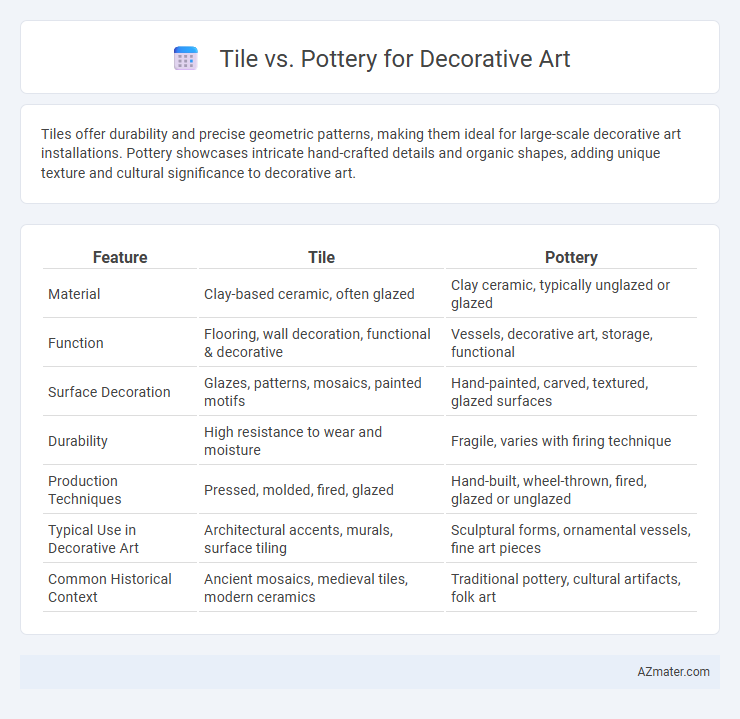Tiles offer durability and precise geometric patterns, making them ideal for large-scale decorative art installations. Pottery showcases intricate hand-crafted details and organic shapes, adding unique texture and cultural significance to decorative art.
Table of Comparison
| Feature | Tile | Pottery |
|---|---|---|
| Material | Clay-based ceramic, often glazed | Clay ceramic, typically unglazed or glazed |
| Function | Flooring, wall decoration, functional & decorative | Vessels, decorative art, storage, functional |
| Surface Decoration | Glazes, patterns, mosaics, painted motifs | Hand-painted, carved, textured, glazed surfaces |
| Durability | High resistance to wear and moisture | Fragile, varies with firing technique |
| Production Techniques | Pressed, molded, fired, glazed | Hand-built, wheel-thrown, fired, glazed or unglazed |
| Typical Use in Decorative Art | Architectural accents, murals, surface tiling | Sculptural forms, ornamental vessels, fine art pieces |
| Common Historical Context | Ancient mosaics, medieval tiles, modern ceramics | Traditional pottery, cultural artifacts, folk art |
Introduction to Decorative Art: Tile vs Pottery
Tile and pottery are essential mediums in decorative art, each offering distinct textures and visual appeal through ceramic craftsmanship. Tile provides versatile surface coverings often used for murals and architectural embellishments, featuring intricate glazing techniques and geometric patterns. Pottery showcases sculptural forms such as vases and bowls, emphasizing hand-crafted shapes and traditional firing methods that highlight cultural artistry.
Historical Origins of Tile and Pottery Art
Tile and pottery art both trace their origins to ancient civilizations, with pottery emerging around 10,000 BCE as functional ceramics used for storage and cooking. Tiles appeared later, around 4,000 BCE in Mesopotamia, serving architectural and decorative purposes with glazed and painted surfaces. The historical significance of tile art lies in its use in intricate mosaics and wall adornments, while pottery is renowned for its varied forms and painted motifs reflecting cultural narratives.
Material Differences: Clay, Glaze, and Surface
Tile and pottery differ significantly in their material composition, with tile typically made from denser, finer clay that undergoes higher temperature firing for durability and water resistance. Pottery often uses coarser clay mixed with organic materials, resulting in more porous and varied textures ideal for artistic expression. Glazing on tiles is usually uniform and glossy to enhance surface hardness, while pottery glazes vary widely from matte to glossy, offering diverse tactile and visual effects tailored to decorative art.
Techniques in Tile Making vs Pottery Crafting
Tile making techniques emphasize precision in molding, glazing, and firing to create durable, flat surfaces suitable for intricate patterns and architectural applications. Pottery crafting involves wheel throwing or hand-building methods, focusing on shaping functional forms followed by glazing and kiln-firing that allow for varied textures and artistic expressions. Both crafts utilize kiln firing processes but differ significantly in their approach to form, surface treatment, and intended use in decorative art.
Design Versatility: Patterns and Motifs
Tile offers exceptional design versatility with a wide range of patterns and motifs, including geometric shapes, floral designs, and intricate mosaics, allowing for seamless customization in decorative art. Pottery provides unique, handcrafted surface designs often characterized by organic motifs and textures that emphasize artisanal craftsmanship and cultural heritage. Both mediums enable creative expression, but tile's precision in repeating patterns makes it ideal for large-scale installations, while pottery excels in one-of-a-kind, sculptural pieces.
Durability and Maintenance Comparison
Tiles generally offer greater durability than pottery due to their dense, hard-fired composition, making them resistant to chipping, cracking, and moisture. Maintenance of tiles is simpler, requiring only regular wiping with mild cleaners, whereas pottery often demands delicate handling and specialized cleaning to prevent damage and preserve intricate designs. The longevity of tiles in high-traffic or outdoor environments surpasses that of pottery, which is more prone to wear and environmental degradation.
Artistic Expression: Form, Function, and Style
Tile and pottery both offer unique avenues for artistic expression, with tiles providing sleek, geometric forms that emphasize repetitive patterns and vibrant glazes ideal for large-scale installations. Pottery showcases organic shapes and tactile surfaces, allowing artists to explore three-dimensional functional art with intricate hand-painted designs. Each medium balances form, function, and style differently, with tiles excelling in structured decor and pottery emphasizing individual craftsmanship and utilitarian beauty.
Cost Considerations: Tile vs Pottery Artworks
Tile artworks generally offer a more cost-effective option compared to pottery due to lower material and production expenses, especially when produced in larger quantities. Pottery artworks often involve higher costs because of labor-intensive handcrafting, kiln firing, and unique glazing techniques that enhance their artistic value. Budget-conscious collectors may prefer tiles for affordability and durability, while pottery appeals to those investing in distinctive, artisan-created pieces despite the higher price.
Popular Uses in Modern Interior Design
Tiles are widely favored in modern interior design for their durability, water resistance, and versatility, making them ideal for kitchen backsplashes, bathroom walls, and flooring. Pottery, often seen in decorative vases, bowls, and sculptural art pieces, adds an artisanal touch and texture that enhances cozy, eclectic, and rustic interiors. Both materials complement contemporary aesthetics, with tiles offering sleek, geometric patterns and pottery providing handcrafted uniqueness.
Choosing Between Tile and Pottery for Your Space
Choosing between tile and pottery for your decorative art depends on the desired aesthetic and functional use. Tiles offer durability, easy maintenance, and versatility for wall and floor applications, making them ideal for high-traffic or moisture-prone areas. Pottery brings unique handcrafted appeal and texture, perfect for accent decor or display pieces that enhance spatial character without the need for heavy use.

Infographic: Tile vs Pottery for Decorative Art
 azmater.com
azmater.com